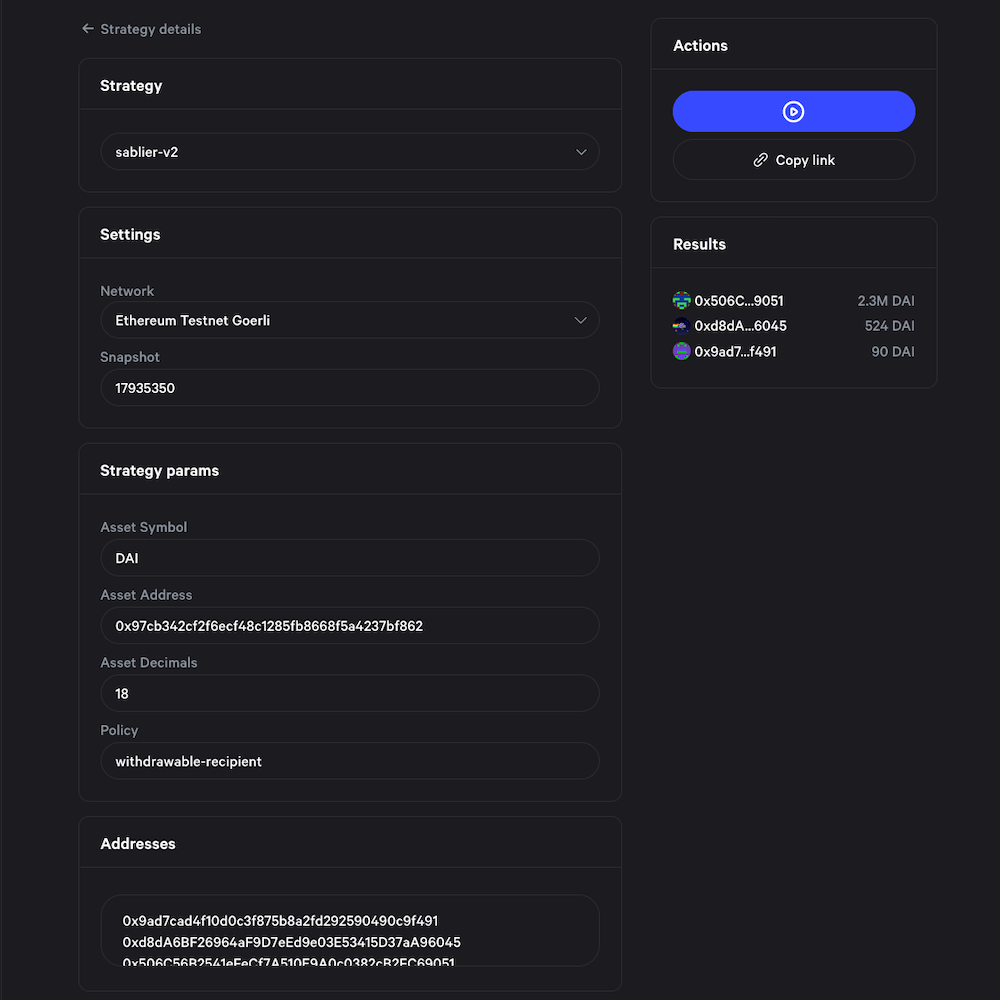Snapshot Voting Strategies
To enable off-chain governance, we designed a collection of Snapshot Strategies that compute the voting power of assets stored in Sablier streams.
Sablier V2
- Snapshot playground - test the strategies
- Snapshot code repository - see the implementation
The following strategies will read the various amounts that can be found in Sablier V2 streams. The voting power will be
calculated based on some sub-strategies called policies.
| Snapshot Playground |
|---|
 |
Example Setup
{
"address": "0x97cb342cf2f6ecf48c1285fb8668f5a4237bf862",
"symbol": "DAI",
"decimals": 18,
"policy": "withdrawable-recipient" // recommended,
}
Other parameters
Aside from this example setup, we use Snapshot's base parameters Network, Snapshot (block), and Addresses.
Based on the chosen strategy, the values filled in the Addresses field will represent a list (>= 1) of senders or
recipients.
Policies
Primary policies
| Policy | Methodology |
|---|---|
| withdrawable-recipient | Tokens that are available for the stream's recipient to withdraw. |
| reserved-recipient | Tokens available for withdraw aggregated with unstreamed tokens. |
Secondary policies
These policies are designed to address specific edge cases. We strongly recommend using the primary policies.
| Policy | Methodology |
|---|---|
| deposited-recipient | Tokens that have been deposited in streams the recipient owned at snapshot time. |
| deposited-sender | Tokens that have been deposited in streams started by the sender before the snapshot. |
| streamed-recipient | Tokens that have been streamed to the recipient until the snapshot. |
| unstreamed-recipient | Tokens that have not yet been streamed to the recipient at the time of snapshot. |
Example
Sablier V2 Stream #000001
---
Deposited: TKN 1000 for 30 days
Withdrawn: TKN 450 before snapshot
Snapshot: Day 15 (midway) with a streamed amount of TKN 500
+------------------------+----------+
| POLICY | POWER |
+------------------------+----------+
| erc20-balance-of | TKN 450 |
+------------------------+----------+
| withdrawable-recipient | TKN 50 |
+------------------------+----------+
| reserved-recipient | TKN 550 |
+------------------------+----------+
| deposited-recipient | TKN 1000 |
+------------------------+----------+
| deposited-sender | TKN 1000 |
+------------------------+----------+
| streamed-recipient | TKN 500 |
+------------------------+----------+
| unstreamed-recipient | TKN 500 |
+------------------------+----------+
Recommendation
For the best results, we recommend using the primary policies.
- The best option is to combine the
withdrawable-recipientpolicy witherc20-balance-of. Doing so will aggregate tokens streamed but not withdrawn yet, as well as tokens in the user's wallet. - The second best option is to combine
reserved-recipientwitherc20-balance-of. They will aggregate (i) tokens streamed but not withdrawn yet, (ii) unstreamed funds (which will become available in the future), and (iii) the tokens in the user's wallet.
Details and Caveats
withdrawable-recipient ⭐️
The withdrawable amount counts tokens that have been streamed but not withdrawn yet by the recipient.
This is provided using the
withdrawableAmountOf contract
method.
Voting power: realized (present).
reserved-recipient ⭐️
The reserved amount combines tokens that have been streamed but not withdrawn yet (similar to withdrawable-recipient)
with tokens that haven't been streamed (which will become available in the future). Can be computed as
reserved = withdrawable + unstreamed === deposited - withdrawn. Canceled streams will only count the final
withdrawable amount, if any.
Voting power: realized (present) + expected (future).
deposited-recipient
Aggregates historical deposits up to the snapshot time, counting only the streams owned by the recipient.
- Streaming, canceling and streaming again will cause tokens to be counted multiple times.
deposited-sender
Aggregates historical deposits up to the snapshot time, counting only the streams started by the sender.
- Streaming, canceling and streaming again will cause tokens to be counted multiple times.
- Takes into account streams created through PRBProxy instances configured through the official Sablier Interface.
streamed-recipient
Aggregates historical amounts that have already been streamed to the recipient. Crucially, withdrawn tokens are included.
It relies on the streamedAmountOf method in the
SablierV2Lockup contract.
- Using this policy alongside
erc20-balance-ofmay double count tokens. In the example above,TNK 500was streamed, but the recipient withdrewTKN 450, so the total voting power would beTKN 950. - If funds are recycled (streamed, withdrawn and streamed again) the voting power may be increased artificially.
unstreamed-recipient
The opposite of streamed-recipient, counting amounts that have not been streamed yet (locked, but will become
available in the future). Subtracts the streamed amount from the initial deposit. For canceled streams, the
unstreamed amount will be 0.
Sablier V1
- Snapshot playground - test the strategies
- Snapshot code repository - dive into the implementation
The Sablier V1 strategy regards the stream recipient as the voter. It returns the voting power for any voter as the sum of all deposits made by a sender towards the recipient (the voter) for a specific ERC-20 token.
- Similar to the Sablier V2
streamed-recipientstrategy, the voting power can be increased artificially.
Example Setup
{
"sender": "0xC9F2D9adfa6C24ce0D5a999F2BA3c6b06E36F75E",
"token": "0x7f8F6E42C169B294A384F5667c303fd8Eedb3CF3"
}